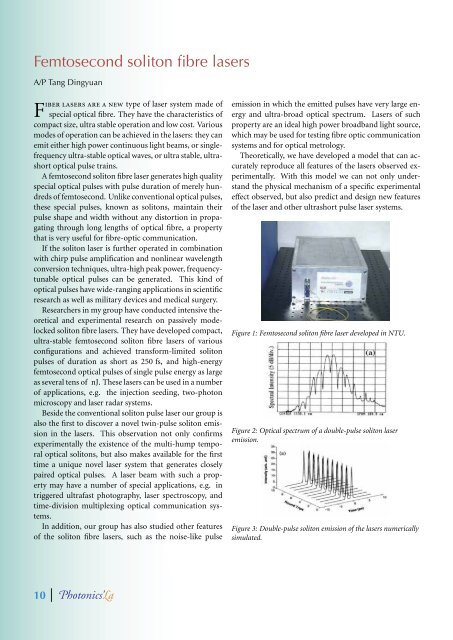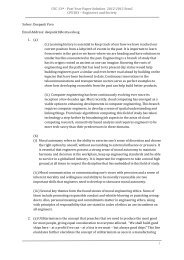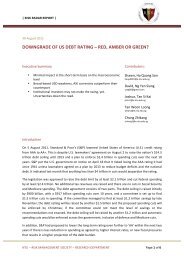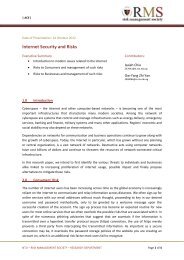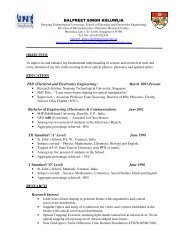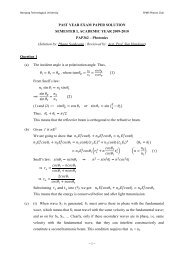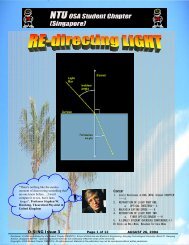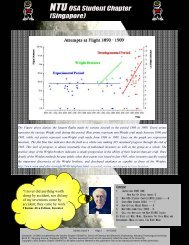PhRC NEWSLETTER PHOTONICS'La - Nanyang Technological ...
PhRC NEWSLETTER PHOTONICS'La - Nanyang Technological ...
PhRC NEWSLETTER PHOTONICS'La - Nanyang Technological ...
Create successful ePaper yourself
Turn your PDF publications into a flip-book with our unique Google optimized e-Paper software.
Femtosecond soliton fibre lasers<br />
A/P Tang Dingyuan<br />
Fiber lasers are a new type of laser system made of<br />
special optical fibre. They have the characteristics of<br />
compact size, ultra stable operation and low cost. Various<br />
modes of operation can be achieved in the lasers: they can<br />
emit either high power continuous light beams, or singlefrequency<br />
ultra-stable optical waves, or ultra stable, ultrashort<br />
optical pulse trains.<br />
A femtosecond soliton fibre laser generates high quality<br />
special optical pulses with pulse duration of merely hundreds<br />
of femtosecond. Unlike conventional optical pulses,<br />
these special pulses, known as solitons, maintain their<br />
pulse shape and width without any distortion in propagating<br />
through long lengths of optical fibre, a property<br />
that is very useful for fibre-optic communication.<br />
If the soliton laser is further operated in combination<br />
with chirp pulse amplification and nonlinear wavelength<br />
conversion techniques, ultra-high peak power, frequencytunable<br />
optical pulses can be generated. This kind of<br />
optical pulses have wide-ranging applications in scientific<br />
research as well as military devices and medical surgery.<br />
Researchers in my group have conducted intensive theoretical<br />
and experimental research on passively modelocked<br />
soliton fibre lasers. They have developed compact,<br />
ultra-stable femtosecond soliton fibre lasers of various<br />
configurations and achieved transform-limited soliton<br />
pulses of duration as short as 250 fs, and high-energy<br />
femtosecond optical pulses of single pulse energy as large<br />
as several tens of nJ. These lasers can be used in a number<br />
of applications, e.g. the injection seeding, two-photon<br />
microscopy and laser radar systems.<br />
Beside the conventional soliton pulse laser our group is<br />
also the first to discover a novel twin-pulse soliton emission<br />
in the lasers. This observation not only confirms<br />
experimentally the existence of the multi-hump temporal<br />
optical solitons, but also makes available for the first<br />
time a unique novel laser system that generates closely<br />
paired optical pulses. A laser beam with such a property<br />
may have a number of special applications, e.g. in<br />
triggered ultrafast photography, laser spectroscopy, and<br />
time-division multiplexing optical communication systems.<br />
In addition, our group has also studied other features<br />
of the soliton fibre lasers, such as the noise-like pulse<br />
10 hotonics'a<br />
emission in which the emitted pulses have very large energy<br />
and ultra-broad optical spectrum. Lasers of such<br />
property are an ideal high power broadband light source,<br />
which may be used for testing fibre optic communication<br />
systems and for optical metrology.<br />
Theoretically, we have developed a model that can accurately<br />
reproduce all features of the lasers observed experimentally.<br />
With this model we can not only understand<br />
the physical mechanism of a specific experimental<br />
effect observed, but also predict and design new features<br />
of the laser and other ultrashort pulse laser systems.<br />
Figure 1: Femtosecond soliton fibre laser developed in NTU.<br />
Figure 2: Optical spectrum of a double-pulse soliton laser<br />
emission.<br />
Figure 3: Double-pulse soliton emission of the lasers numerically<br />
simulated.


